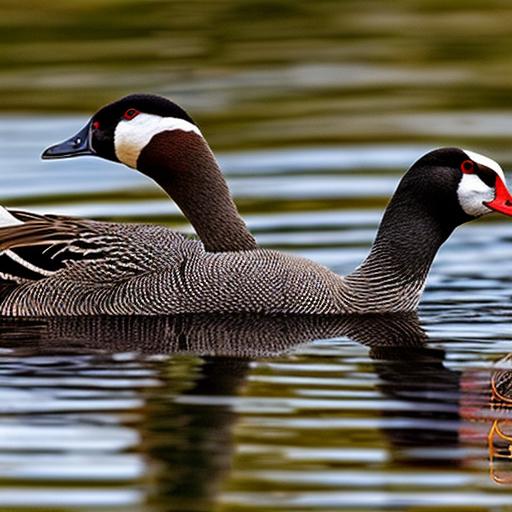Geese are a type of waterfowl that belong to the Anatidae family, which also includes ducks and swans. There are several different breeds of geese, each with its own unique characteristics and traits. Geese have been domesticated for thousands of years and are raised for their meat, eggs, and feathers. They are also popular as pets and for their role in conservation efforts. Understanding the different breeds of geese and their specific traits is important for anyone interested in raising or studying these fascinating birds.
Physical Characteristics and Differences
Geese come in a variety of sizes and colors, with some breeds being much larger than others. The most common physical characteristics of geese include a long neck, webbed feet, and a distinctive honking sound. Some breeds, such as the Toulouse and Embden, are known for their large size and plump bodies, making them popular choices for meat production. Other breeds, like the Chinese and African, are smaller and known for their ornamental value. Geese also come in a wide range of colors, including white, gray, and brown, with some breeds having unique patterns and markings. Understanding the physical differences between geese breeds is important for breeders and conservationists looking to preserve and protect specific traits and characteristics.
Behavioral Traits and Temperament
Geese are known for their strong social bonds and protective nature, making them excellent guardians for other poultry and livestock. They are also highly intelligent and can be trained to perform a variety of tasks. Some breeds, such as the Chinese and African, are known for their calm and gentle temperament, making them popular choices for backyard pets. Other breeds, like the Embden and Toulouse, are more assertive and can be aggressive towards strangers or predators. Understanding the behavioral traits and temperament of different geese breeds is important for anyone considering raising geese, as it can help ensure a harmonious and productive relationship between the birds and their human caretakers.
Geographical Distribution and Habitat
Geese are found in a wide range of habitats around the world, including wetlands, grasslands, and agricultural areas. They are highly adaptable and can thrive in both natural and human-altered landscapes. Some breeds, such as the Chinese and African, are native to Asia and Africa, while others, like the Toulouse and Embden, have been developed in Europe and North America. Geese are also migratory birds, with many species traveling long distances between their breeding and wintering grounds. Understanding the geographical distribution and habitat preferences of different geese breeds is important for conservation efforts, as it can help identify and protect critical areas for these birds.
Breeding and Reproduction
Geese are monogamous birds, forming strong pair bonds that can last for life. They are also prolific breeders, with females laying a large number of eggs each year. Some breeds, such as the Chinese and African, are known for their early maturity and high egg production, making them popular choices for commercial egg production. Other breeds, like the Toulouse and Embden, are valued for their large size and meat production. Understanding the breeding and reproduction habits of different geese breeds is important for anyone interested in raising geese, as it can help ensure successful breeding and healthy offspring.
Importance in Agriculture and Conservation
Geese have been an important part of agriculture for thousands of years, providing meat, eggs, and feathers for human consumption. They are also valuable for their role in pest control, as they can help keep insect populations in check. In addition, geese play a crucial role in conservation efforts, as they are important indicators of wetland health and biodiversity. Some breeds, such as the Chinese and African, are also raised for their ornamental value, contributing to the preservation of rare and endangered breeds. Understanding the importance of geese in agriculture and conservation is important for anyone interested in sustainable farming and wildlife management.
Cultural Significance and Symbolism
Geese have been an important part of human culture and folklore for centuries, with many cultures around the world incorporating geese into their myths, legends, and traditions. In some cultures, geese are seen as symbols of loyalty, courage, and vigilance, while in others they are associated with fertility, abundance, and good fortune. Geese are also popular subjects in art, literature, and music, with their distinctive honking sound and graceful flight inspiring countless works of creativity. Understanding the cultural significance and symbolism of geese is important for anyone interested in the intersection of human and natural history.
Popular Breeds and Varieties
There are many different breeds and varieties of geese, each with its own unique characteristics and traits. Some of the most popular breeds include the Toulouse, Embden, Chinese, and African. The Toulouse is known for its large size and meat production, while the Embden is valued for its white feathers and calm temperament. The Chinese and African breeds are smaller and known for their ornamental value, making them popular choices for backyard pets. In addition to these breeds, there are many other varieties of geese, each with its own distinct color, pattern, and markings. Understanding the popular breeds and varieties of geese is important for anyone interested in raising or studying these birds.
Unique Adaptations and Survival Strategies
Geese have a number of unique adaptations and survival strategies that have allowed them to thrive in a wide range of habitats and environments. Their long necks and webbed feet make them well-suited for swimming and foraging in water, while their strong social bonds and protective nature help them defend against predators. Geese are also highly adaptable and can thrive in both natural and human-altered landscapes, making them valuable indicators of environmental health and biodiversity. Understanding the unique adaptations and survival strategies of geese is important for anyone interested in wildlife biology and conservation.
Conservation Efforts and Challenges
Despite their adaptability and resilience, geese face a number of conservation challenges, including habitat loss, pollution, and hunting pressure. Many species of geese are also threatened by climate change, which is altering their breeding and wintering grounds. Conservation efforts for geese include habitat restoration, captive breeding programs, and public education and outreach. In addition, international agreements and treaties, such as the Migratory Bird Treaty Act, provide legal protections for geese and their habitats. Understanding the conservation efforts and challenges facing geese is important for anyone interested in wildlife conservation and environmental stewardship.
Meet Walter, the feathered-friend fanatic of Florida! Nestled in the sunshine state, Walter struts through life with his feathered companions, clucking his way to happiness. With a coop that’s fancier than a five-star hotel, he’s the Don Juan of the chicken world. When he’s not teaching his hens to do the cha-cha, you’ll find him in a heated debate with his prized rooster, Sir Clucks-a-Lot. Walter’s poultry passion is no yolk; he’s the sunny-side-up guy you never knew you needed in your flock of friends!







